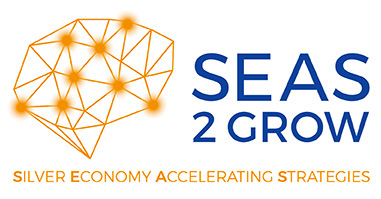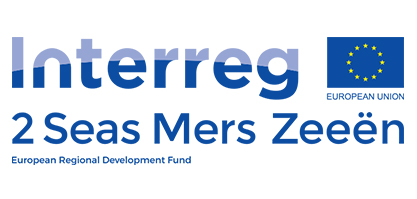The Anglia Ruskin University, the Care Innovation Center and LiCalab have implemented and brought their experience of the living lab model during the SEAS 2 Grow project. They have answered some questions about their involvement in the project and living lab activities.
Anglia Ruskin University
Dr. Pamela Knight-Davidson
Research Fellow, Co-Investigator SEAS 2 Grow Project
Faculty of Health, Education, Medicine and Social Care, Anglia Ruskin University
Tell us how your living-lab is designed and how it works
Our living lab was established in 2016 as a virtual platform providing support to businesses and entrepreneurs developing products for the older peoples’ market – the Silver Economy. It operated on consultancy and contract basis and also provided research partnerships with other academic institutions, health and care providers, and innovators. Since August 2020, the Living Lab became part of the ageing research cluster in our University which succeeded the Positive Ageing Research Institute.
How do you arrange the tester panels? How are they chosen?
We have an established panel of users who were recruited for testing during the SEAS 2 Grow project and who have committed to working with us for future living lab projects. We recruit people from this panel for individual projects if they fit the testing criteria and we may also advertise for new through NHS, social care, and community partners. In some cases, we have also used personal contacts to take part in testing.
Is the elderly your main target audience?
Currently yes. Depending on the age range of the target group for particular products, this can range from 55 and older. We would also like to focus on work with disadvantaged groups such as people from minority backgrounds and so we are interested in innovations that address social issues of these groups.
How do you engage with stakeholders?
We have established contacts with local authority providers and commissioners and also with a couple of nursing home groups and with community groups, specifically for the living lab work – but we also have research partners as part of our university work, and we can call on them for help with the living lab.
What do you retain from the SEAS 2 Grow experience?
Working in ageing research is challenging – engaging with stakeholders is not easy but however very necessary. The biggest lesson is to learn to maintain close relationships with stakeholders in order to engage them more easily when it comes to our living lab work. I have learned most of what I know form the work of the other living labs.
How was the partnership with the different stakeholders? with companies?
Working with industry is a goal for our university. SEAS 2 Grow has helped me to become more confident in doing this type of engagement work. The biggest stand out is when I came across the term TRL. I had not got a clue and had to go home and read and understand it. That was my experience in the first stages of SEAS 2 Grow, now I’m much more confident speaking with businesses and innovators.
What did the SEAS 2 Grow project bring you?
I learned a lot about project management and as indicated above about working with industry partners.
Can you explain what the testing process within S2G was?
Mostly co-creation, involving about 8-10 people at a time. This was new to me and seemed like a focus group to start with – however I soon learned the difference, a co-creation session focuses on the product and participants in the session give direct feedback about features of the product whereas in a focus group you are exploring ideas about a particular topic – this is a feature of a co-creation session also but with the product feedback being key.
There was also life testing of products which was more challenging. These were running a mini research project – preparing a protocol and test documentation and questionnaires.
I thought the human factor studies were very interesting and would like to learn more about these.
Business advice sessions also featured in SEAS 2 Grow – although I had limited engagement with these sessions, I have come to appreciate how businesses can benefit from them – I did find though that not many business wanted to take them up as a living lab service.
Do you plan to sustain your activities with the elderly audience after the end of SEAS 2 Grow? How do you plan to do it?
Yes – we developed a business plan for the living lab and will continue to work with SMEs developing and innovating in the older peoples’ market. We will focus much more on research outputs however as this is a requirement of research work in the university. Because of this we will also focus on those businesses who are seeking funds through grants.
Are there activities you want to perform into the AgeTech Accelerator International?
As above, we will continue to be an associate partner in AgeTech Accelerator International as a provider of living lab services.
Have you already planned other projects? In that case, can you give us some examples of activities you want to be involved in?
We are currently working with an SME on a bid to Innovate UK to undertake research using living lab methods that will lead to the development of a diabetes application for ethnic minority groups.
Care Innovation Center
Chantal van Spaendonck
Director
Care Innovation Center – Wast Brabant
Natascha van Riet
Project Officer
Care Innovation Center – Wast Brabant
Tell us how your living-lab is designed and how it works
Care Innovation Center has a wide network especially in the province of Brabant in the Netherlands. In the board of CIC are the directors of two nursing homes and one hospital. One of the nursing homes is tanteLouise who is also partner in SEAS 2 Grow. The other Dutch partner is Smart Homes. They have a ‘home’ where you can test certain products in a real-life setting. We also have a lot of health and care organizations and SMEs joining our living lab activities.
How do you arrange the tester panels? How are they chosen?
It depends on the innovation it involves. Because of our wide network we can select a relevant health care organization and ask them if they want to test it with their patients or can help us to get in contact with the relevant target group. We also have a national panel of at the moment 225 participants that is growing who we can involve in the testing.
Is the elderly your main target audience?
Not exclusively, we are involved in all kind of innovations in the care sector. Though most innovations are developed for the elderly because of the ageing population.
How long have you been involved in the living lab activities?
Since our start, 6 years.
How do you engage with stakeholders?
We are a network organization. We organize a variety of events and are partner in several national and international projects. For example, the regional preliminary round of the Dutch National Care Innovation Award, the Health Innovation School, Anderswerken in de zorg, CrossCare and of course SEAS 2 Grow. We also invite the entrepreneurs of SEAS 2 Grow to pitch their innovation on some events. The audience are health care organisations, entrepreneurs, people of local and national authorities, end-users and end-user organisations, educational and research partners.
What do you retain from your SEAS 2 Grow experience?
It’s important to be involved in an international collaboration. You learn about interesting innovations in other countries which can be very relevant for care organisations in the Netherlands. It’s also good that you can help Dutch entrepreneurs with more information about and contacts in other countries to test or even implement their innovation in these countries.
How was the partnership with the different stakeholders? with companies?
It’s been a great collaboration with the other partners involved in SEAS 2 Grow. It gave us a lot of insights in how healthcare is organized in the different countries but also how the ecosystem for startups and SMEs is organized. And of course we learned a lot about the differences in cultures which are important for the cross-border innovations.
What did the SEAS 2 Grow project bring you?
A new network, interesting new innovations, great contacts abroad and insights in how the Silver Economy ecosystem works in the other countries.
Can you explain what was the testing process within SEAS 2 Grow?
We did different things: organizing co-creation sessions, life testing, market studies and business model sessions.
Do you plan to sustain your activities with the elderly audience after the end of SEAS 2 Grow? How do you plan to do it?
Yes, we will continue as partner in AgeTech Accelerator International and also in other projects.
Are there activities you want to perform into the AgeTech Accelerator International?
Yes, we want to be a living lab partner and the coordinator of the Dutch AgeTech Accelerator.
Licalab
Vicky Van der Auwera
Operations Manager
LiCalab
Tell us how your living-lab is designed and how it works
LiCalab started in 2011 as an initiative of City of Turnhout. From the beginning on the city collaborated with Thomas More University of Applied Sciences and Janssen Pharmaceutica to create a sustainable strategy. In 2013 LiCalab became a non-profit organization and received funding from the Flemish government (2013-2016) via the Care Innovation Program for Living Labs’. We started up our operations at that time with 1 coordinator, 1 panelmanager and 1 projectmanager. We supported 7 regional projects at that time and 2 EU-projects. Since October 2019 LiCalab is fully incorporated as a Research Unit within Thomas More University of Applied Sciences. Our team counts 8 people and in the past year we managed 35 business projects and 7 EU-funded projects. LiCalab focuses as well on services for businesses and care organisations as on applied (user) research.
We manage a large panel of approximately 1.000 individuals and 600 health care organisations and professionals. LiCalab involves the end user during the whole process of innovation by exploration, co-creation, real life testing and business advice.
How do you arrange the tester panels? How are they chosen?
LiCalab build up the panel during the past years: 2 fulltime panelmanagers recruit panel members via generic activities (presentations, fairs, networking, panel events, city events etc.). Recruitment can also be project based if a specific target group needs to be approached. (e.g. diabetes patients, autism, heart failure, people with dementia etc.). In this case we also collaborate with patient representatives, patient groups and care organisations.
Is the elderly your main target audience?
We started with a panel of elderly in 2013, but throughout the years the panel became more diverse because of different types of projects: chronic patients, informal carers, disabled persons, (active and healthy) citizens, youngsters etc.
How long have you been involved in the living lab activities?
LiCalab was founded in 2011. Ever since we delivered living lab activities for companies, care organisations, local and regional authorities and research institutes. We collaborate with other research groups that have specific scientific expertise to support us in evidence based methods when necessary.
How do you engage with stakeholders?
By involving them in activities (group discussions, co-creation sessions, market studies, business advice, real life testing etc.) We also meet regional stakeholders via the Health and Care Network in our region and other regional network events. We have build up a large international community by collaborating with international partners and being active members of ENOLL, EIT-Health, EIP-AHA, AAL-community. We also publish an online monthly newsletter, where stakeholders react upon.
What do you retain from your SEAS 2 Grow experience?
Good collaboration with partners that can also be continued after the program.
We learned from the big variety of projects and services.
We gained insights in the health care ecosystems of other countries.
Our network of international partners has grown throughout SEAS 2 Grow.
It was also nice to share knowledge between the regional living labs as leader of this activity. We hope that partners could learn from our experience and expertise and will become sustainable in their region. We hope to collaborate with them in other future (international) projects as well.
How was the partnership with the different stakeholders? with companies?
We kept close contact with the companies and project partners by monthly telco’s. Regional stakeholders that were involved in our living lab activities were kept notified during the different SEAS 2 Grow-cases and received feedback to keep them engaged.
What did the SEAS 2 Grow project bring you?
Good international contacts. By working together closely, you gain trust.
Exchange of knowledge and expertise.
By doing a lot of different projects and a lot of different services we could engage our user panel on a very regular basis. And above that, we could expand our panel.
We also delivered quite some market studies and business advice through which we gained expertise on several topics by performing desk research and interviewing experts.
Can you explain what was the testing process within SEAS 2 Grow?
A lead region was chosen right from the beginning (at the selection phase), that was responsible for setting up scenarios and protocols.
Then, a kick-off meeting was set up between SEAS 2 Grow-partners and involved companies. To get to know each other and each other’s expectations. To learn more on the innovation, motivation, status of the development and expectations of the companies towards the SEAS 2 Grow-services.
Services and timeline were discussed. During the monthly telco’s the lead regions followed up the activities and the upcoming actions with the SEAS 2 Grow-partners involved and to monitored the progress.
Do you plan to sustain your activities with the elderly audience after the end of SEAS 2 Grow? How do you plan to do it?
Yes! We will keep on engaging the user panel in other projects and activities. Since we already had quite a large panel of elderly users, we could sustain and expand this panel, by keeping them involved throughout diverse and interesting innovations/products.
Are there activities you want to perform into the AgeTech Accelerator International?
Yes, we plan on being involved on:
- exploration
- co-creation
- expert interviews
- life testings
- human factor studies
- market studies
As well as networking with regional and international partners and stakeholders (pitch events, matchmaking events etc.) and regional business development for the AgeTech Accelerator Belgium.
Have you already planned other projects? In that case, can you give us some examples of activities you want to be involved in?
We’d like to stay connected with international partners via EU-funded projects (Horizon Europe, Interreg, ESF, ERDF, etc.) in Health and Care innovation (focus on technology and new collaboration models). We invest in this by having a fulltime project writer in our team that engages with other potential (international) partners.
Regionally we build up strategic partnerships with both governments, business, care organisations as end user organization. We recently launched Care Heart Kempen together with Health and Care Network Kempen to engage stronger with regional stakeholders.
We work together with Flemish Government in Interreg-project ACSELL to support policy making for enhanced SME-competitiveness via a living-lab approach.
We work together with City of Turnhout in ERDF-project SLIM co-creation (Make City Living Innovative). This gives opportunities for us to be active as well in Citizen Science and Smart Cities-projects.
We are working on a proposal Interreg VL-NL ‘Care2Adapt’ together with other SEAS 2 Grow-partners CIC West-Brabant and Tante Louise.




